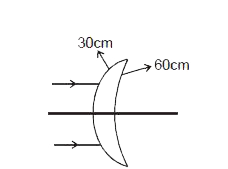Calculate the focal length of the lens shown in the figure.

Video Solution
Text Solution
1f=(μlμs−1)(1R1−1R2)
⇒1f=(1.5−1)(+130(+160))
⇒f=120 cm

If in the above case direction of rays is reversed.
1f=(μlμs−1)(1R1−1R2)
⇒1f=(1.5−1)(−160−(−130))
f=+120 cm
This Illustration shows that focal length does not depend on the incident ray direction.

|
Topper's Solved these Questions
- GEOMETRICAL OPTICSBook:MOTIONChapter:GEOMETRICAL OPTICSExercise:Exercise - 1 Section A - Plane Mirror
Explore 12 Videos
- GEOMETRICAL OPTICSBook:MOTIONChapter:GEOMETRICAL OPTICSExercise:Exercise - 1 Section B, C, D, E - Mirror formula and Magnification, Velocity in Spherical Mirror, Cutting of Mirrors, Combination of Mirrors, Intensity of light
Explore 10 Videos
- FLUIDBook:MOTIONChapter:FLUIDExercise:Exercise-4 level-II
Explore 5 Videos
- GRAVITATIONBook:MOTIONChapter:GRAVITATIONExercise:Exercise - 4 Section - B Previous Years Problems
Explore 15 Videos
Similar Questions
Knowledge Check

The focal length of the convex lens isA+10 cmB+20cmC−10cmD−20cmThe focal length of a lens depends on
Acolour of lightBradius of curvature of the lensCmaterial of the lensDall the above

Find the focal length of the lens as shown in figure.
View SolutionFind the focal length of the lens shown in Fig.

View SolutionFind the focal length of the lens shown in the figure. The radii of curvature of both the surfaces are equal to R

View SolutionDefine focal length of a lens.
View SolutionThe focal length of a convex lens is
View SolutionThe power of a concave lens is -2.5 dioptres. Find it focal length.
Calculate the focal length of a corrective lens having power +2.5 D.
View Solution

